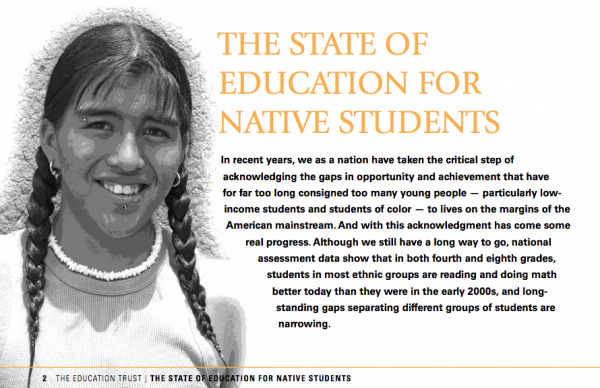 By Rob Capriccioso, Indian Country Today Media Network
By Rob Capriccioso, Indian Country Today Media Network
The Education Trust, a nonprofit organization that focuses on student achievement gaps, has released a new report, “The State of Education for Native Students,” and the state is not good—to say the least.
The report, issued in August, notes that despite recent progress in improving achievement among most students of color, achievement results for Native students have remained nearly flat, and as achievement has stagnated, the gaps separating Native students from their peers have mostly widened.
The hard numbers are eye-opening. “In 2011, only 18 percent of Native fourth-graders were proficient or advanced in reading on the National Assessment of Educational Progress (NAEP), compared with 42 percent of white fourth-graders,” the report states. “In math, only 17 percent of Native eighth-graders were proficient or advanced, and nearly half (46 percent) performed below even the basic level. For white students, the pattern was almost exactly the reverse, with 17 percent below basic and 43 percent proficient or advanced.” NAEP results for Native students improved more slowly between 2005 and 2011 than for any other major ethnic group. “As a result, while Native students were performing better in fourth-grade reading and eighth-grade math than African American and Latino students in 2005, by 2011 that lead had all but disappeared,” the report finds.
On the higher education front, the report finds that of the Native students who enrolled in a four-year college in the fall of 2004, only 39 percent completed a bachelor’s degree within six years. It was the lowest graduation rate for any group of students.
“Our country’s focus on raising achievement for all groups of students has left behind one important group—Native students,” said Kati Haycock, president of the Education Trust, in a statement. “To ensure that all Native students succeed, we must do more and better for them starting now.”
“There’s an urgent need to pick up the pace of improvement for Native students in this country,” added Natasha Ushomirsky, Education Trust’s senior data and policy analyst and author of the brief.
The good news is that the poor trends are far from inevitable, as the report points out that some states, schools and institutions of higher education are already working hard to ensure progress for Native students.
Still, there’s a long, long way to go, said Native education experts who have reviewed the report.
Quinton Roman Nose, executive director of the Tribal Education Departments National Assembly, said the report paints a dire picture that Indian education experts have long been asking the federal government to heed and change for the better. He believes the information presented in the report offers a starting point for more research as to why there has been little progress under the Obama administration for Native students. “I wish there were more information regarding local partnerships between tribes, local education agencies and state education agencies,” Roman Nose added. “The recent State Tribal Education Partnership grant has awarded four grants to have tribal education agencies partner with local education agencies and state education agencies in developing selected title programs from the Elementary and Secondary Education Act.”
Heather Shotton, president of the National Indian Education Association, said her organization is “troubled” by the achievement statistics highlighted in the report, but it helps to focus on some success stories that illustrate these trends are not irreversible.
“As noted in the report, some states are currently raising Native academic achievement outcomes,” Shotton said. “Among other successes, increased tribal and Native community involvement in Oregon and Oklahoma ensure Native-serving schools include culture-based education and provide resources for language immersion, which as research shows, increases academic outcomes.”
But the biggest problem for both programs that are struggling and for those that are succeeding in aiding Native students, Shotton said, is ongoing federal sequestration that inordinately harms Indians dependent on federal funds.
“[S]equestration has limited the success of such programs—disproportionately affecting America’s most vulnerable populations,” Shotton said. “For tribes and educators working tirelessly to reverse the disparaging statistics, sequestration has reduced budgets, increased class sizes, and reduced staff when Native students need them most.”
RELATED: Every Child Left Behind: Sequester Guts Indian Education, Part 1
NIEA is currently asking federal lawmakers to leave Native education programs held unharmed as sequestration continues to be implemented, or for Congress to work with the Obama administration to implement a planned reduction measure, rather than across-the-board cuts that disproportionately diminish the education of those who need it most—Native students.
Read more at http://indiancountrytodaymedianetwork.com/2013/09/24/native-education-situation-dire-says-report-sequestration-not-helping-151426
